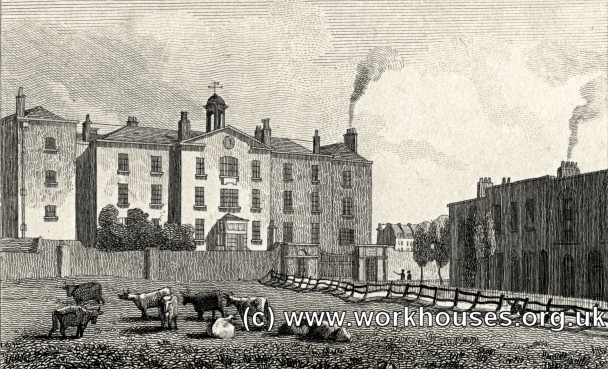The story of Patience Emily Wooler/Wooller, Randy's great grandmother, is both sad and inspirational. She overcome a less than optimistic start in life to marry and raise nine children in England in the late 19th century and the beginning of the next.
The above photo of Patience in about 1900 came from a great granddaughter who has a locket that contains this picture. It no doubt belonged to Patience's daughter Elsie and then her daughter Vi and now her daughter Sharon. She was Randy's great grandmother as well, born three days less than exactly 100 years later!
Patience Emily Wooler was born on November 13, 1859 in Battersea, London, England. This is an inner-city district of south London but further research made me look deeper for the story. Patience Emily was born in the Islington Workhouse.
 |
| A view of Islington Workhouse from 1819, from http://www.workhouses.org.uk/Islington/ |
you are a lot like me. A fascinating history of the workhouses can be found online at http://www.workhouses.org.uk/
Ann was born second of nine children in 1839 to Edward Wooller and the former Sarah Wood. In the 1841 and 1851 census, Edward is identified as an "Ag Lab", which I interpret as a farm worker. In the 1851 census where Ann is 12 years old, her occupation line is blank where her nine year old sister is noted as a scholar. I assume from that Ann did not attend school but stayed home to help with the housework and younger children. An unfortunate thing then happened and Ann found herself pregnant and single. As Peter Higginbotham says on the above noted website,
Under the new Act, the threat of the Union workhouse was intended to act as a deterrent to the able-bodied pauper. This was a principle enshrined in the revival of the "workhouse test" — poor relief would only be granted to those desperate enough to face entering the repugnant conditions of the workhouse. If an able-bodied man entered the workhouse, his whole family had to enter with him.Life inside the workhouse was was intended to be as off-putting as possible. Men, women, children, the infirm, and the able-bodied were housed separately and given very basic and monotonous food such as watery porridge called gruel, or bread and cheese. All inmates had to wear the rough workhouse uniform and sleep in communal dormitories. Supervised baths were given once a week. The able-bodied were given hard work such as stone-breaking or picking apart old ropes called oakum. The elderly and infirm sat around in the day-rooms or sick-wards with little opportunity for visitors. Parents were only allowed limited contact with their children — perhaps for an hour or so a week on Sunday afternoon.To understand how Patience came to be born there is in the story of her mother, Ann (below).
Ann was born second of nine children in 1839 to Edward Wooller and the former Sarah Wood. In the 1841 and 1851 census, Edward is identified as an "Ag Lab", which I interpret as a farm worker. In the 1851 census where Ann is 12 years old, her occupation line is blank where her nine year old sister is noted as a scholar. I assume from that Ann did not attend school but stayed home to help with the housework and younger children. An unfortunate thing then happened and Ann found herself pregnant and single. As Peter Higginbotham says on the above noted website,
Unmarried pregnant women were often disowned by their families and the workhouse was the only place they could go during and after the birth of their child.It is amazing to me that the admission of Ann to the workhouse and her 4 day old unbaptised daughter is available online at Ancestry. It says they arrived from 20 Albert Terrace on Balls Pond Road nearby. The discharge "At her own request" on November 25 is also there along with the baptismal record for the same day at Islington Parish in the county of Middlesex.
Luckily for us, Patience did not become a victim of the so called Baby Farmers of the time that would accept the illegitimate babies for a fee and then more often that not, the babies would become sickly and die. The 1861 census of England shows young Patience living with her grandparents in Arlington and Ann is a house servant for Simeon and Emma Miers in Bloomsbury, about 70 miles apart. Miers was a merchant and with six children and 2 house servants, and ten years earlier he was noted to be a shoe maker and hosier. Six years later, in February of 1867 Ann married James Sanders, a domestic servant or coachman. They went on to have a family of 4 girls and 3 boys.
After being raised by her grandparents, Patience married in 1878 at the age of 18 to a carpenter, James William Bushby (above). I wonder if she ever had contact with her mother or half sisters and brothers or even knew the true story of her birth. With hundreds if not thousands of descendants across the world today, Patience made her mark despite a rocky beginning.





No comments:
Post a Comment